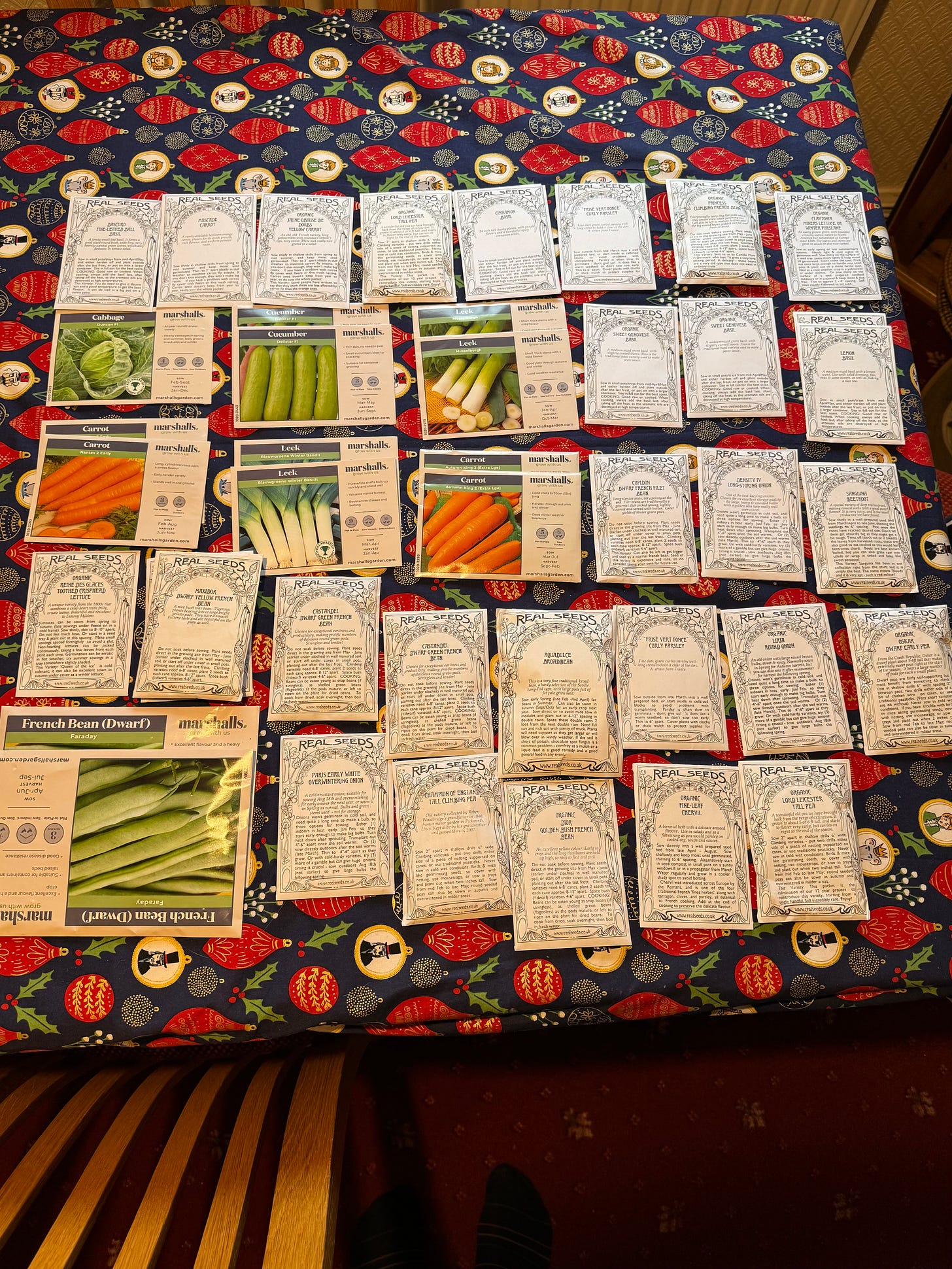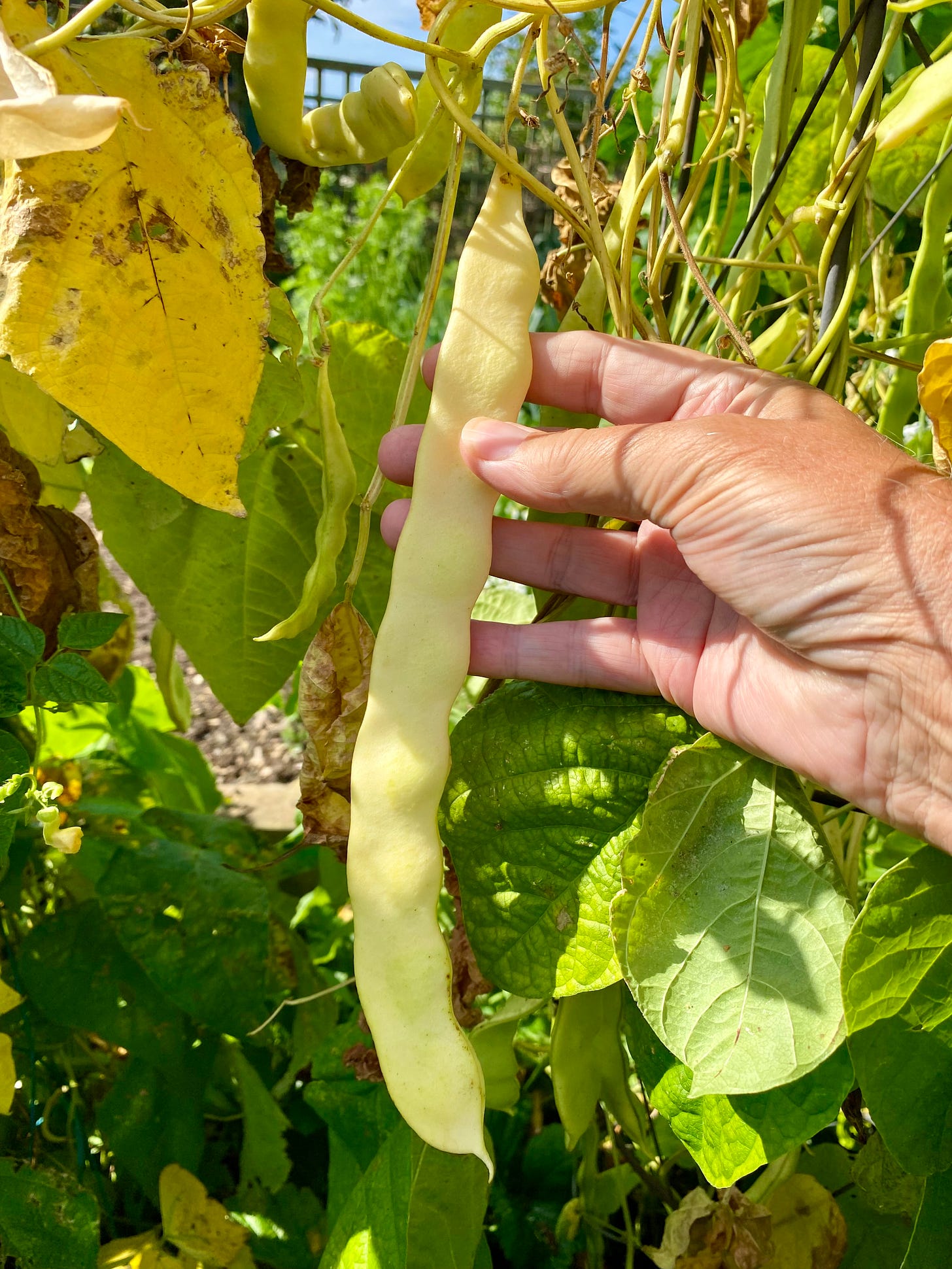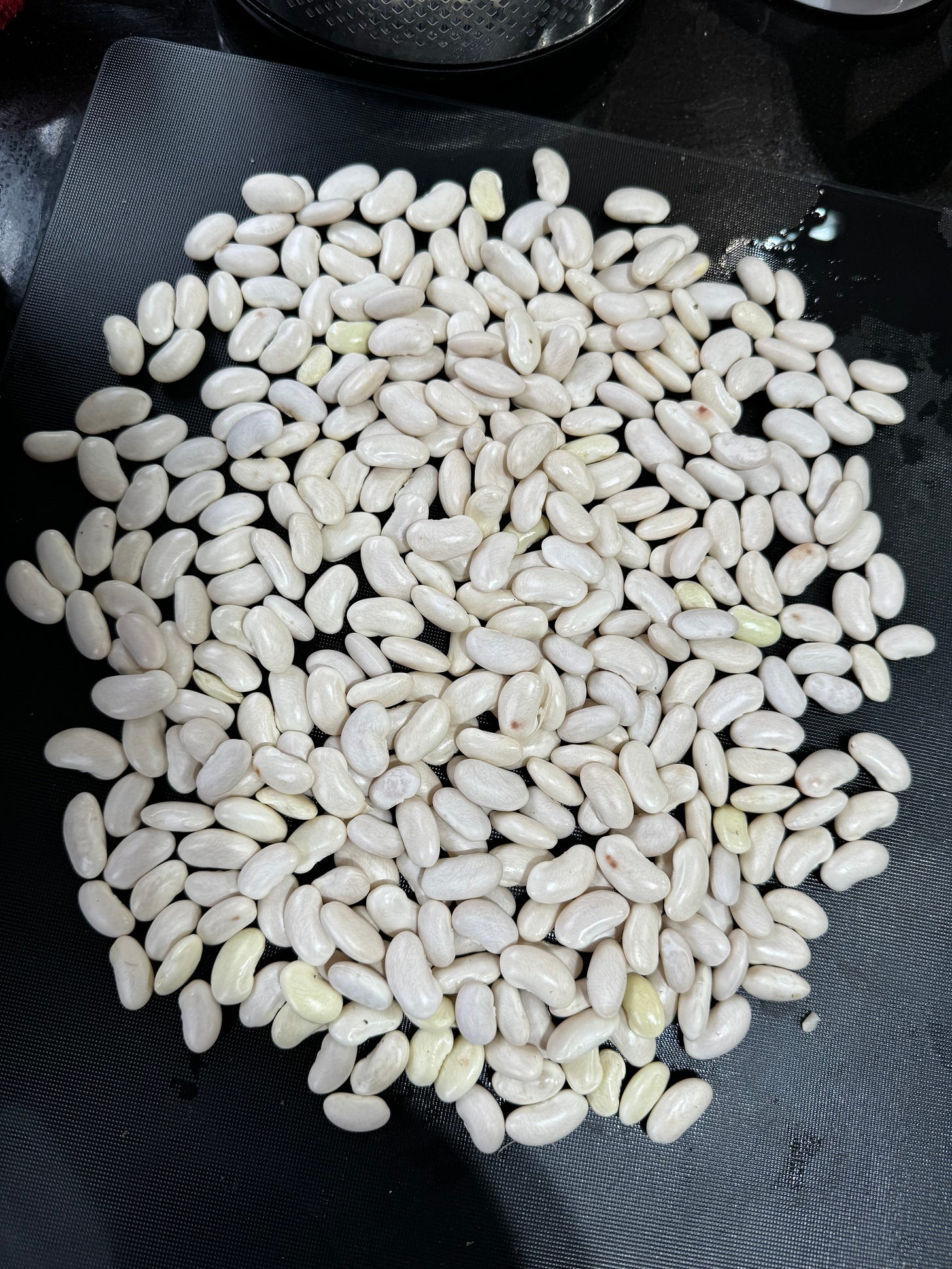Seed-saving.
One of the most difficult challenges for me in any given year, and always whilst in the throws of harvesting my crops in August to eat or store over winter, is waking up to the fact that, all of a sudden, it’s time to switch modality and begin earmarking which plants I want to save my seeds from - because, if I don’t, the best of the crop gets picked and eaten, and the genetic frontrunners are lost for posterity. Not only so, but timing’s critical; all seeds must be fully ripe/mature, in order to germinate reliably the following season, and that ‘ideal window’ will be narrowed further still, if the weather turns nasty, which inevitably it will. Wet seeds won’t store. So, when the penny finally drops, I start watching the local forecast like a hawk, as decision-day approaches. It’s for me, now, an exciting and compulsive venture, and part and parcel of cultivating good strong vegetables. I certainly get a buzz from it, I can’t explain.
Above: 1st of October last year, jalapeños and various types of tomatoes and French beans, ready for deseeding and saving. 99% of the jalapeños were frozen whole and are still in use today, whilst the offspring of those I deseeded are currently ripening in the greenhouse; and so the cycle goes on.
So, why bother? Well, it’s rewarding keeping your own bloodlines going year after year; they become an irrepressible part of your own private enterprise and creativity. Of course, it saves money, too. Commercially available seeds are becoming more and more expensive and often the number of seeds in some packets, like tomatoes and cucumbers, is shrinking fast. On top of all that, the serious gardener needs reliability with regard to obtaining key crops; it’s not always easy to get your hands on what worked well the year before - even something as simple as a radish. Some lines mysteriously vanish in a manner that makes no sense at all. Having said that, my goto for most all of my seed stock is reliable, and what’s more they promote the ethos of saving seeds: Real-Seeds in the UK not only sells great seeds at a fair price, they give free advice on how and when to collect and save your own supply.
A Christmas present to myself for the last ten years in my happy place, and it never wanes, is the ritual making of a large and extravagant order from their catalogue, mid-December, occasionally trying old varieties they have recovered from near-extinction, and restocking on lines that, quality and yield-wise, are almost too good to be true. It’s a voyage of discovery, we get to enjoy as a family around the dining-table.
Above: My December 2023 gift to self. It took all of my ingenuity to find room for these in my garden; but I did.
How skilled do you need to be?
I began to save seeds around fifteen years ago, when I began to balk at paying £4-odd for ten or less seeds of some F1 variety I was keen on growing again - usually tomatoes, cucumbers, sprouts or leeks. So, whilst I’m not a novice, I do still consider myself a relative newcomer, still extending my scope and improving my own bloodlines as I go on. If I can do it, so can you…
Above: My flat-pod, stringless Algarve French bean bloodline is now 15 years old and going strong. This pod is almost ready for picking and shelling.
How easy is the actual process?
Although the list is probably endless, there’s no denying some seeds are easier to collect and keep than others. Tomatoes, coriander, beetroot, spinach, peas, beans and radish readily go to seed and can be dried and stored over winter in a cool dry place, with no pampering. As long as they’re dry, they’ll keep no problem at all, and germinate readily the following spring. These seven are my basics. This year, I’m adding most all my herbs, leeks and possibly White Lisbon spring onions.
Above: But one of many flowering spurs on a spinach plant, this second week of August, ripe for the picking and drying. They are multi-germ and store well.
Which plants for a beginner?
If you’re new to the idea, plants that set seed in their first year are the easiest to start your seed-saving strategy with: tomatoes, beans, peas, coriander, jalapeños, chervil, basil, beetroot, radish, rocket and spinach, for example. Other vegetables spend their first year storing food in their roots or stems and then flower the following season: cabbages, caulis, onions, leeks and carrots for example. They need room set aside, if you’re going to attempt saving their seeds, whilst the rest of the plot provides your family with food. So, I only bother occasionally, out of interest: leeks, carrots and cutting celery are this year’s fancy.
Above: Cutting-celery seed, harvested this very morning, to avoid damage from a storm due tonight, at midnight. The seeds and flowering heads smell divine and can be used in cooking.
Saving seed from shop-bought fruit:
That’s an easy one to answer. Seeds scraped from the outside of your favourite strawberry, pips from apples and pears, and stones from cherries or plums will all germinate in pots. The key to remember is that cultivated fruit trees are grafted onto dwarf root-stock to bring forward their fruiting season and make them type-true, and yours won’t be. You’d be in it for the long haul and it will be a ‘new variety’ - your very own. Strawberries will fruit the following year. Best to nip those flowers off, so the strawberries put their energy into strong growth.
Above: Seven tiny Ava Magnum seedlings, scraped off a strawberry and sown July ‘23 onto the surface of the compost in a 4” pot, and repotted on 7th Feb this year. They’re now 12” tall and trying to set fruit. It’s too early for that. Their fruits will be 2” long, if all goes to plan.
Plants that resow themselves around the garden: Chives, Greek Oregano, Dill, Coriander and Fennel need no encouragement to set seed, wherever autumn winds blow them. So far, I’ve not found that to be too much of an issue, as they bring in pollinators and pest-killers in droves, in the form of various types of bee and parasitic wasps and hover-flies. No garden should be without at least several of these plants.
Above: Greek Oregano flowers in August and but one of many, many pollinators - this one is a type of hover-fly.
My method for all the self-desiccating seed-heads, which is every plant I can think of except tomatoes and cucumbers, is to harvest seeds at the point of ripeness during dry weather and to store them for a while in an open container to dry out even further. The point to remember is that even wood in a dry house has around 8% water content and wood in a garage around 12-15%. Nothing is ever totally dry. So, I will often store my beans, coriander, radish, beetroot and spinach seeds in open jars, labelled and dated, in the garage over winter, so that they can breathe. I do run a dehumidifier, but that’s for my wood. The seeds would keep regardless. It works really well. If unsure, leave the seeds to dry another week or two longer in the house, before storing.
Above: Last gasp Algarve seeds rescued just before a southwesterly storm-front hit, last November 16th. Not all of them were up to scratch. Some are spotty.
Tomatoes, on the face of it, are messy. In fact, it’s a cinch, harvesting seeds from the best fruits taken from the strongest, most productive vines, squeezing out as many seeds as I want onto a paper kitchen towel to dry (labelled beforehand). I then leave the towels in the utility for several weeks, out back, open to the atmosphere. They soon dry out and they don’t fester. Whilst I’m at it, I do the same with my jalapeños; it’s just a foible of mine. The flesh of the seed tomatoes and jalapeños gets eaten; nothing goes to waste. I store those seeds in a cupboard, along with my coffee and spices in the utility. That way I know where to look come February, when I start to make my early sowings. Nothing worse than having to search for stuff.
Above: Sowing several varieties of tomato seeds torn from the paper towels, and loose jalapeño seeds sown three to a cell. It’s easy then to select the strongest plant and snip out the weaker with nail scissors.
Below: This is what motivates me to carry on and do more. These are my Picolino’s, a bloodline as long as the Algarve’s at around 15 years. Not the best photo (taken through the greenhouse glass), there are 50-plus tomatoes to each truss. I also have a younger line in Picobello’s, Piccolo’s, San Marzano’s, Jubilee and Burlesque.
Failures: So far, I’ve failed miserably trying to harvest cucumber and courgette seeds, though I’m told it can be done. I’ve managed to harvest their seeds from over-ripe fruits; but none of them germinated properly the following year.
Storing seed longterm: Seeds don’t keep forever. The longer you keep them, the more the DNA deteriorates and the fewer will germinate when sown. I’ve beans and peas I’ve kept for 3-4 years and had to use out of extremity; they did germinate, but not as vigorously or in the numbers I’m used to; and some died later on, in the face of inclement weather, when stronger plants would have survived. I also have a few jars of radish and spinach seeds which go back a few years and are still producing healthy plants.















I am a novice at seed saving, but nearly 50% of my garden this year is my own seeds, and they are doing well. I am in growing zone 5b in Canada, so I try to plant accordingly.